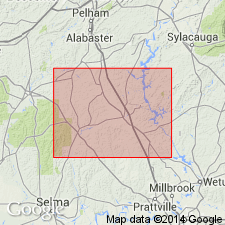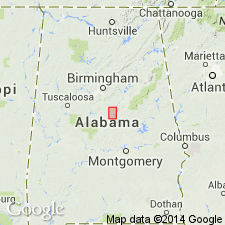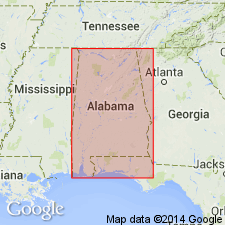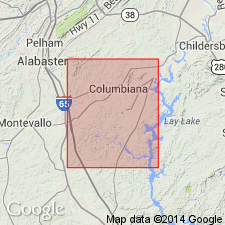
- Usage in publication:
-
- Stumps Creek Formation
- Modifications:
-
- Named
- Dominant lithology:
-
- Slate
- AAPG geologic province:
-
- Piedmont-Blue Ridge province
Summary:
Stumps Creek Formation, formerly referred to as Stumps Creek Tongue of Wash Creek Slate (Warren, 1970: Alabama Acad. Sci. Abstract, v. 41, no. 3, p. 148), is described here as green, fine-grained, laminated slate, 370 m in thickness. Gradationally overlies Brewer Phyllite. Age given as middle Paleozoic.
Source: GNU records (USGS DDS-6; Reston GNULEX).

- Usage in publication:
-
- Stumps Creek Formation
- Modifications:
-
- Revised
- Age modified
- AAPG geologic province:
-
- Piedmont-Blue Ridge province
Summary:
Several units are redefined in this report and assigned to the Kahatchee Mountain Group, including the Stumps Creek Formation. Gradationally underlies Wash Creek Formation and gradationally overlies Brewer Formation. Age given in this report is Early Cambrian.
Source: GNU records (USGS DDS-6; Reston GNULEX).

- Usage in publication:
-
- Stumps Creek Formation
- Modifications:
-
- Overview
- AAPG geologic province:
-
- Piedmont-Blue Ridge province
Summary:
Stumps Creek Formation of Kahatchee Mountain Group consists of grayish-green parallel- and cross-laminated micaceous, feldspathic, arenaceous metamorphosed siltstone, fine-grained metamorphosed sandstone, and green phyllite. Locally contains interbeds of dark-green fine- to medium-grained pyritic quartzite. A hematitic feldspathic, locally cross-bedded metamorphosed sandstone occurs near the top of the Stumps Creek. Unit was originally defined as a Tongue of Wash Creek Slate by Warren (1969) in an unpublished M.S. thesis. When the Kahatchee Mountain Group was originally defined by Tull (1982), the Stumps Creek was not included as a constituent formation. Subsequent work by Guthrie (1985), however, indicated that the Stumps Creek has sufficient thickness and areal extent to require formal status as a formation within the Kahatchee Mountain Group overlying the Brewer Phyllite and underlying the Wash Creek Slate. Nomenclature of Guthrie (1985) is followed here. Age given in this report as Late Precambrian(?) to Cambrian(?).
Source: GNU records (USGS DDS-6; Reston GNULEX).

- Usage in publication:
-
- Stumps Creek Formation
- Modifications:
-
- Revised
- AAPG geologic province:
-
- Piedmont-Blue Ridge province
Summary:
A distinctive quartzite interval within the middle of the Stumps Creek Formation of the Kahatchee Mountain Group is here named the Watson Creek Sandstone Member. The Stumps Creek crops out in a relatively continuous belt across the southern part of the study area. Thickness is relatively constant, ranging between 2,047 ft and 2,648 ft. Consists mostly of siltstone and fine-grained sandstone, distinctive rock types being olive-gray to grayish-olive-green shale and micaceous arenaceous siltstone. Bedding ranges from massive to thin. Some trough cross-bedding is found in fine- to medium-grained sandstone interlayered with shale. A fine-grained bioturbated sandstone, which weathers to mottled light-brown, olive-green, and pink occurs in the lower part of the unit. Age is Early Cambrian(?).
Source: GNU records (USGS DDS-6; Reston GNULEX).
For more information, please contact Nancy Stamm, Geologic Names Committee Secretary.
Asterisk (*) indicates published by U.S. Geological Survey authors.
"No current usage" (†) implies that a name has been abandoned or has fallen into disuse. Former usage and, if known, replacement name given in parentheses ( ).
Slash (/) indicates name conflicts with nomenclatural guidelines (CSN, 1933; ACSN, 1961, 1970; NACSN, 1983, 2005, 2021). May be explained within brackets ([ ]).

